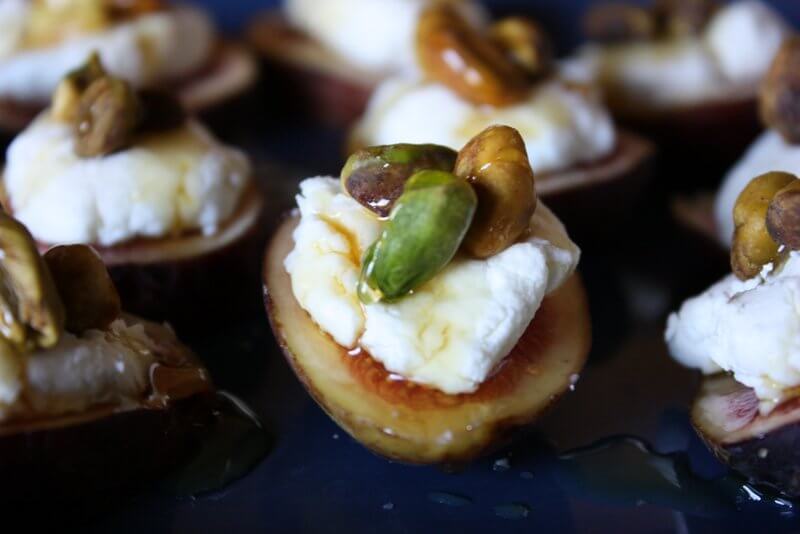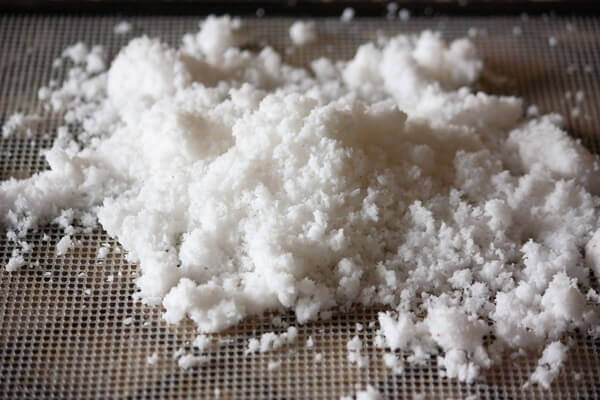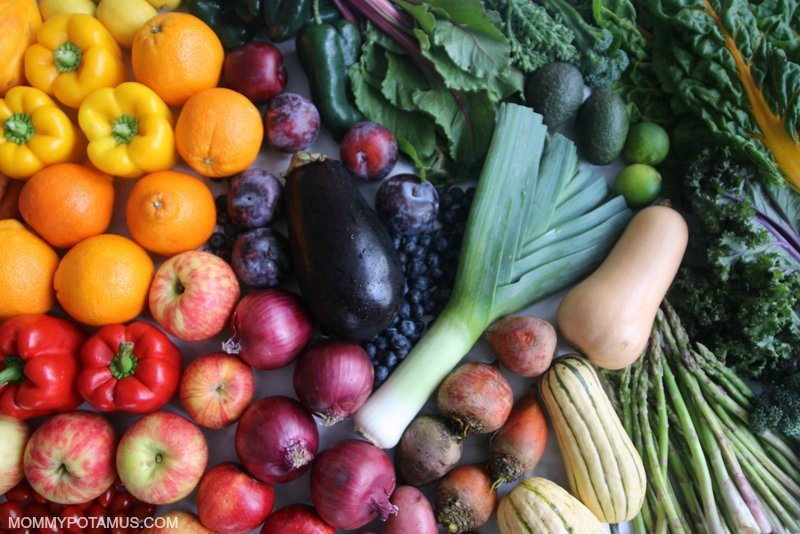
I’m all about eating healthy on a budget right now, which is why I’m loving the inexpensive box of organic fruits and veggies that’s delivered to my door every week from Misfits Market. They sell imperfect, occasionally odd-looking fruits and veggies that won’t get sold in stores for about 40% off retail, which has helped my family save quite a bit this year.
If you want to try them out you can get 25% off your first box with coupon code COOKWME-IQ4XEZ, or if you have a great local resource, that works too!
Either way, having access to healthy fruits and veggies only matters if they stay fresh enough for us to enjoy them all, right?
With that in mind, over the past few months I’ve been researching and experimenting with how to store vegetables and fruits so that they stay crisp, juicy, and flavorful for as long as possible.
I discovered I was storing a few things wrong (oops!), plus several helpful tips I’d never heard before (yay!). Here’s what I learned:
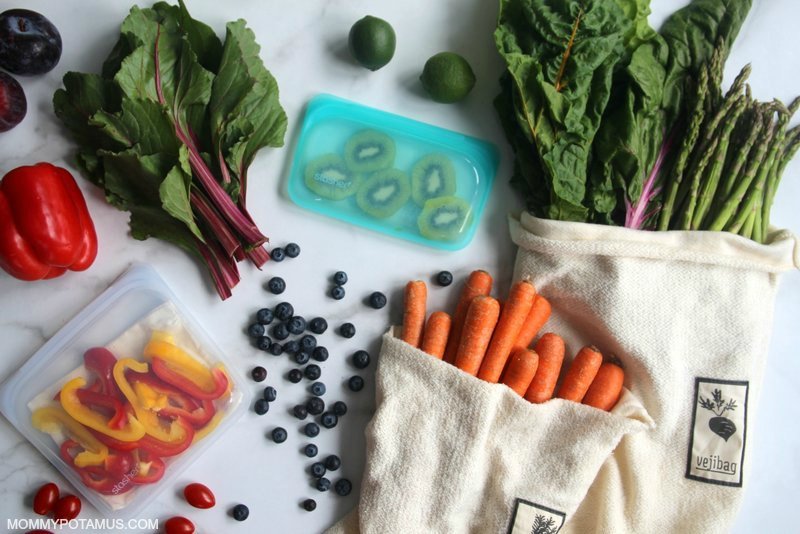
Good, Better & Best Storage Bag Options ^
Fruit and veggies have “personalities” in a sense, except instead of being introverts and extroverts their characteristics center around their storage-style preferences. Some need a lot of moisture, while others prefer drier conditions or they will become slimy (think mushrooms). They all seem to do best when they can breathe, so plastic bags are not optimal.
You’ll find a handy, categorized list for each fruit and veggie later in this article, but first let’s talk about the best storage container options:
Good:
- Clean towels – Many of our grandmothers wrapped moisture-loving veggies like carrots in damp kitchen towels before storing them in the fridge. Organic cotton is best because it’s both breathable and free of heavy pesticide residue. The downside of this approach is that towels can be bulky and take up more space than other option, and they may be too thick or thin to hold optimal moisture levels. In a pinch they will work, though!
- Bees Wrap bags or homemade reusable food wrap – These two options are both breathable, which I like. However, they aren’t as effective as other options for helping produce maintain moisture levels, so I tend to use them to cover leftovers, wrap sandwiches, etc.
Better:
- Sealable, reusable storage bags – Some produce can do fairly well in a resealable storage bag with either small cotton cloths or paper towels tossed in. The cloths can be either be dry (to absorb moisture) or damp (to add moisture) depending on what’s needed. I love these bags because they are made with food-grade silicone and can also be used as freezer bags or store dry pantry goods because they seal well. You can also write on them with a ball-point pen or dry erase marker and then wipe them clean with a damp cloth before reusing.
- Reusable cotton produce bags – These are a great alternative to the single-use plastic bags available at the grocery store. They’re less bulky than kitchen towels and facilitate good airflow, but they tend to dry out sooner than some options. Just like people, produce does best with optimal hydration, which leads me to my favorite option . . . .
Best:
- Breathable, Thick Organic Cotton Storage Bags – So far the best way I’ve found to keep produce fresh is the Vejibag. It’s an organic cotton terry cloth bag that was created to hold just the right amount of moisture to keep most types of produce fresh. Just get it wet, wring it out until it’s lightly damp, then store produce inside. More than one kind of produce can be stored in a bag, which helps maximize space in the fridge. (Just don’t store fruits and veggies in the same bag – we’ll cover why later in this article.)
- Breathable Paper Bags – For certain items like mushrooms and okra. Can also be used to speed up the ripening process for avocados, bananas, etc.
Now where were we? Oh right, it’s not just about HOW to store fruits and veggies, it also matters WHERE you store them, which leads us to . . .
Choosing Where To Store Fruits & Veggies ^
What are optimal pantry conditions, and is it really true that potatoes and onions shouldn’t be stored together? Let’s take a quick look at different ways of storing produce and how to create optimal conditions:
1. Crisper Drawer
Have you ever noticed that your crisper drawer has a sliding handle with “Fruits” or “Low Humidity” on one side and “Vegetables” or “High Humidity” on the other? That’s because – depending on the setting you choose – these special drawers have one of two unique functions:
Fruits / Low Humidity – When on this setting, the drawer has an open vent that allows ethylene gas to escape from the drawer. Fruits such as apples, bananas and mangos produce ethylene, which accelerates the ripening process and can cause produce to spoil more quickly if it’s not released. On the flipside, if you have an underripe piece of produce – say an avocado – you can place it in a paper bag with a banana and the concentrated ethylene gas will help it ripen more quickly.
Vegetables / High Humidity – When on this setting, the vents on crisper drawers are mostly closed. This creates a more humid environment, which helps keep certain veggies crisp and fresh for longer. (More on which ones below.)
2. Fridge Shelves
Of course, some fruits and veggies will do just fine outside of the crisper drawer. Examples include beets, carrots and fresh herbs, which are best stored upright in a glass with about an inch of water.
3. Countertop
Stone fruits, citrus, bananas, tomatoes and other fruits are best stored on the counter (out of direct sunlight) while ripening. Some can be moved to the fridge once ripe to extend shelf life, while others may become grainy in texture if transferred.
Experts say that’s true of tomatoes, but I have refrigerated tomatoes and haven’t noticed any drastic difference from room temperature tomatoes.
4. Pantry Or Other Cool, Dry, Dark Place
Certain veggies, including winter squash, onions, and potatoes, can stay fresh for weeks (or longer!) in a cool or room-temperature area, which means you can save your fridge space for produce that has a shorter shelf life. A pantry, kitchen cabinet, closet or garage can all work as long as these conditions are met:
Cool – Ideally with a temperature between 50 and 70 F
Dark & Dry – When veggies are exposed to light and moisture, they’ll think they’re outside and start to sprout.
Good Airflow – Although potatoes and produce are often sold in plastic bags, storing them in the bags can impair ventilation and cause them to spoil faster. We store ours in baskets to facilitate airflow.
Tip: Keep Your Veggies & Fruits Separate
Earlier I mentioned that many fruits produce ethylene gas, which accelerates the ripening process. That can be great for fruit if you’re in a rush to eat it, but veggies don’t really ripen after they’re picked. Instead they wilt, form brown spots and become soft . . . in other words, go bad.
For that reason, it’s best to store veggies and fruits separately when possible. I keep most of my fruits on my kitchen counter, but when I get a big batch of, say, already-ripe peaches for making jam, I store them in a separate crisper drawer from our family’s veggies.
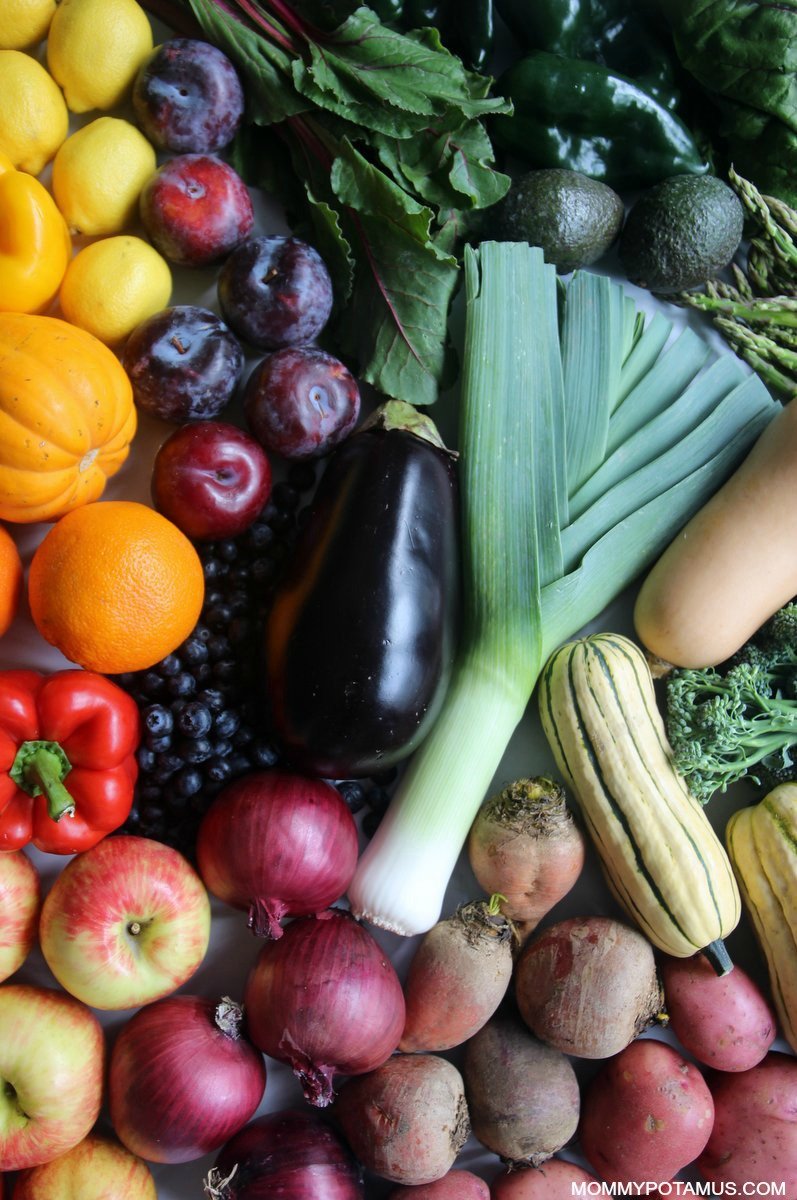
How To Store Vegetables & Fruits ^
The guide below organizes fruits and veggies by shelf life, the best place to store them (countertop, crisper drawer, etc.) and also includes tips for specific foods.
Shelf life of up to 1 week ^
Refrigerator Crisper Drawer
- Artichokes (Store in Vejibag or a reusable storage bag with a damp towel. If the stem is still attached you can also trim the tip off and place it in a little water like a flower)
- Brussels Sprouts (Wrap in a damp kitchen towel, Vejibag, or breathable food wrap; Don’t wash until you’re ready to use them)
- Bok Choy (Store in Vejibag or partially closed storage bag with a damp towel)
- Eggplant(Store loose or in a Vejibag)
- Sugar Snap Peas (Store in Vejibag or a reusable storage bag)
- Snow Peas (Store in a Vejibag or a reusable storage bag)
- Summer Squash (Wrap in slightly damp towel or store in a Vejibag)
- Zucchini(Wrap in slightly damp towel or store in a Vejibag)
Refrigerator Shelf
- Asparagus (Store upright with flat tips in a jar of water with a reusable bag loosely covering the tips. Can also be stored in a Vejibag)
- Cherries (Store in an airtight container/bag between layers of towels/kitchen towels if possible; Don’t wash until you’re ready to use them)
- Cilantro (Store upright with stems in water and a bag loosely covering the leaves. Can also be stored in damp Vejibag if thoroughly leaves are thoroughly dried before placing them in)
- Chives (Remove ties and store upright in a glass with an inch of water and a resealable bag over the green shoots. Can also be stored in a Vejibag or in reusable storage bag with slightly damp towel)
- Fennel (Cut off the stalks and fronds about 2 inches above the bulb. Wrap bulb in a slightly damp towel or store in a Vejibag. Place stalks and fronds in a partially closed storage bag or a Vejibag)
- Grapes (Store in an unsealed bag or original packaging if it has ventilation holes; Grapes tend to absorb odors so try to store away from onions and leeks; Don’t wash until you’re ready to use them)
- Green Beans(Store in a sealable container/bag or Vejibag)
- Mushrooms (Store in a paper bag)
- Okra (Store in a paper bag or unsealed container/bag lined with a towel/paper towel)
- Parsley (Store upright with stems in water and a bag loosely covering the leaves)
- Rhubarb (Wrap in a damp towel/paper towel or store in a Vejibag)
- Strawberries (Store in a shallow container lined with a dry towel or paper towel, leaving the lid slightly cracked for air circulation; Wash only when ready to eat.)
Countertop (Room Temperature)
All produce should be kept out of direct sunlight.
- Apricots, Nectarines and Peaches (Store loose in a cool area)
- Avocados (Store loose or in paper bag if desired to speed up ripening, Refrigerate once ripened)
- Bananas (Store away from apples, avocados, figs, peaches, and tomatoes)
- Cantaloupe (Store loose; If transferred to fridge once ripe will last 3-5 days)
- Honeydew (Store loose; If transferred to fridge once ripe will last 10-15 days whole and 4-5 days when cut in pieces)
- Kiwi(Store loose; If transferred to the fridge once ripe can stay fresh for up to a month)
- Mango (Store loose; If transferred to the fridge once ripe can stay fresh for up to 10 days)
- Pears (Store loose; If transferred to the fridge once ripe can stay fresh for up to 3-5 days)
- Pineapples (Don’t generally ripen after picking; Store on counter and use within 1-2 days, or cut and store in the fridge for 3-5 days)
- Plums (Store loose; If transferred to the fridge once ripe can stay fresh for up to 3-5 days)
- Tomatoes (Store loose)
Shelf life of 1-2 weeks ^
Refrigerator Crisper Drawer
- Peppers such as bell peppers or jalapenos (Store loose or in Vejibag)
- Broccoli (Wrap in a damp towel or store in a Vejibag)
- Celery (Store in a Vejibag or wrap the base of the celery in a damp towel/paper towel and place it in a reusable bag that is left open at the top)
- Ginger (Store in a sealable, reusable storage bag)
- Radishes (Remove leaves and place bulbs in a sealable container/bag with a damp towel/paper towel, or store in a Vejibag)
- Sprouts (Allow to dry fully, then store in an airtight container with a dry cloth or paper towel inside. Can also be stored in a breathable Vejibag that has been moistened)
Refrigerator Shelf
- Blackberries (Store in a shallow container lined with a dry towel or paper towel, leaving the lid slightly cracked for air circulation. Wash only when ready to eat.)
- Blueberries (Store in a shallow container lined with a dry towel or paper towel, leaving the lid slightly cracked for air circulation. Wash only when ready to eat.)
- Cucumbers (Store loose or in a Vejibag)
- Fresh Herbs With Soft Stems like parsley, cilantro, dill, tarragon, and mint but not basil (Trim a little of the stems and store in a glass with about 1 inch water. Cover the leaves loosely with a bag. Change water every few days)
- Fresh Herbs With Hard, Woody Stems like rosemary, thyme, chives, marjoram, sage and oregano (Store in a resealable storage bag with a damp cloth /paper towel or a Vejibag)
- Green Onions (Remove rubber band and wrap in a damp towel/paper towel. Store loose or place inside an open bag. Can also be stored in a Vejibag)
- Leafy Greens like chard, collard greens, mustard greens, kale etc. (Remove bands and ties. Store in a Vejibag or sealed container/bag lined with a damp towel/paper towel)
- Tender Salad Greens like lettuce baby spinach, arugula, etc. (Store in a Vejibag or a sealable container/bag with a damp cloth or paper towel)
- Pears (Store loose or in a paper bag to accelerate ripening)
- Pomegranates (Store loose)
Countertop (Room Temperature)
All produce should be kept out of direct sunlight.
- Apples (Store loose; Apples emit a lot of ethylene gas and will basically accelerate the ripening of anything nearby. They’re best stored away from other produce; Can last 1-2 weeks on the counter or up to 6 weeks in the crisper drawer away from veggies)
- Fresh Basil (Basil tends to turn black when exposed to cold, so it’s best to keep at room temperature. Trim the stems and place them in a glass with about an inch of water. Cover the leaves loosely with a bag and replace the water when it gets cloudy)
- Whole Melons such as cantaloupe or honeydew (Store loose; Once ripe transfer to the fridge)
- Whole Watermelon(Store loose; When whole watermelon is stored in the fridge it loses some if its nutritional content. Store in fridge for up to 3 days after cutting)
Shelf life of 2-3 weeks ^
Refrigerator Crisper Drawer
- Cauliflower (Store in a partially sealed bag or Vejibag)
- Lemons (Store loose in the crisper drawer or on the counter if using within about a week)
- Limes (Store loose in the crisper drawer or on the counter if using within about a week)
- Oranges (Store loose in the crisper drawer or on the counter if using within about a week)
- Scallions (Store in a Vejibag or upright in a glass with 1 inch of water that is changed every few days)
- Leeks (Wrap in a damp towel or Vejibag)
- Parsnips (Wrap in a damp towel or store in a Vejibag; Avoid storing near apples or pears because the gases from either can make parsnips bitter)
- Tomatillos (Store in a paper bag)
Refrigerator Shelf
- Beets (Store in a sealed container with a dry towel, sealable bag with a dry towel, or Vejibag. Store green tops separately.)
- Carrots (Store in damp towel or Vejibag; Store green tops separately)
- Celeriac, also known as celery root (Store in a sealable, reusable storage bag or Vejibag)
Shelf life of 4 or more weeks ^
Refrigerator Crisper Drawer
- Apples (Store loose in the crisper drawer or on the counter if using within about a week)
- Grapefruit (Store loose in the crisper drawer or on the counter if using within about a week)
- Rutabaga (Store in a Vejibag or wrapped in a damp cloth/ paper towel that is placed in an open reusable bag)
- Turnips (Store in a Vejibag or wrapped in a damp cloth/ paper towel that is placed in an open reusable bag)
Refrigerator Shelf
- Cabbage (Store loose or in a Vejibag)
Countertop or Pantry (Room Temperature)
The following produce should be kept out of direct sunlight.
- Onions (Store loose or in a mesh bag away from potatoes. Gases released by onions can cause potatoes to sprout.)
- Shallots (Store away from other veggies)
- Sweet Potatoes (Store loose or in a mesh bag away from onions)
- Garlic (Store loose)
- Potatoes (Store loose or in a mesh bag away from onions)
- Winter Squash like butternut, pumpkin (Store loose)
2 More Tips for Keeping Fruits & Veggies Fresh
1. Freeze Them – Here’s a guide that explains which ones freeze well . . . and which ones definitely don’t.
2. Ferment Them – Before refrigeration, fermentation and drying were the two main ways people extended the shelf life of food. Here are some easy ferments to get you started:
- Fermented Garlic – This fermented garlic is similar to roasted garlic, but with all its enzymes (and many other beneficial compounds) intact. It’s amazing in compound garlic butter, salad dressing & other recipes.
- Kid-Friendly, Probiotic Rich Fermented Carrots – Tangy and crunchy, these carrot sticks make a delicious snack or side dish for meals. Enjoy them plain or dipped in creamy homemade ranch dressing or onion dip.
- Easy Fermented Jalapenos – These “pickled” jalapenos take just a few minutes of hands-on time to make and are a total crowd-pleaser. Serve them on nachos, pizza, Mexican dips, salads, and more for a delicious pop of flavor.
Have a question or tip about storing veggies and fruits? Please leave it in the comments below!

